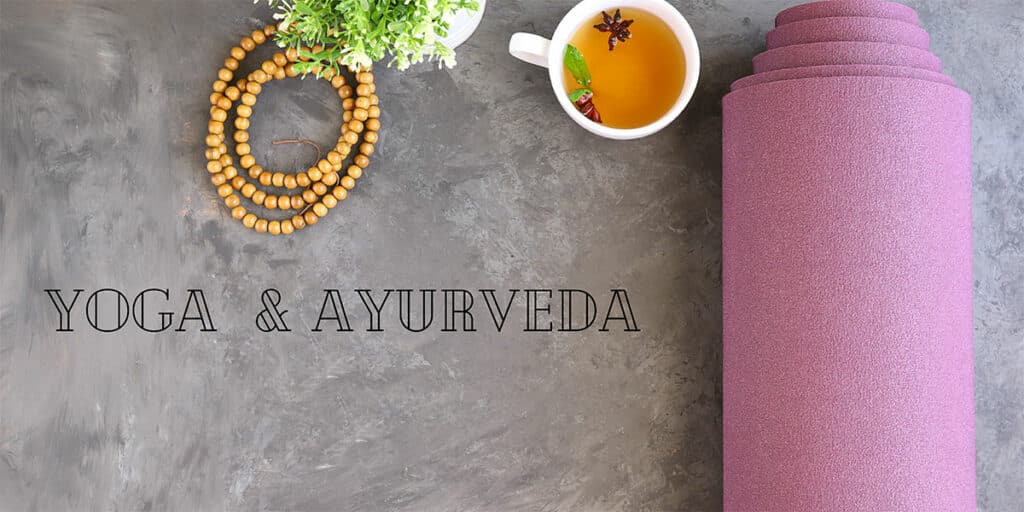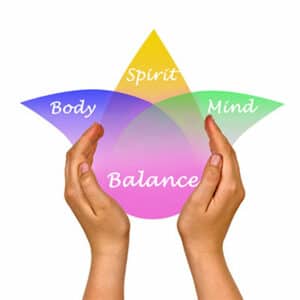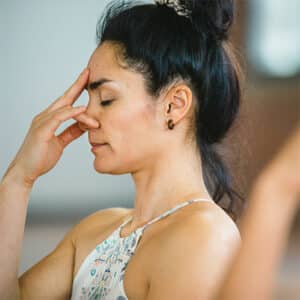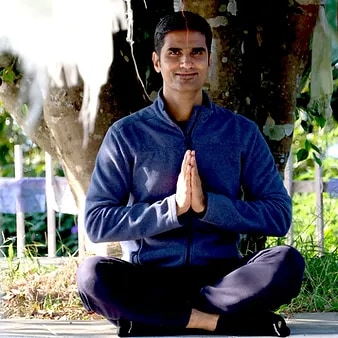Yoga & Ayurveda: An Integrated Approach to Holistic Well-Being
by Hardik Mehta

In the quest for holistic well-being, the ancient sciences of Yoga and Ayurveda emerge as profound guides, weaving a tapestry that encompasses the physical, mental, and spiritual dimensions of human existence. Originating from the same ancient Indian roots, these sister sciences, though distinct, share an intricate relationship, offering a comprehensive approach to achieving balance and vitality. This blog endeavours to explore the symbiotic nature of Yoga and Ayurveda, unravelling the threads that bind them together in the pursuit of optimal health and harmony.
Understanding the Foundations
Yoga and Ayurveda both trace their origins to the Vedic texts, ancient scriptures that form the foundation of Indian philosophy. While Yoga primarily focuses on spiritual development through physical and mental practices, Ayurveda is the science of life, centred around promoting health and longevity through a balanced lifestyle.
The Dosha-Dharma Connection
Central to Ayurveda is the concept of doshas—Vata, Pitta, and Kapha—representing the elemental forces governing the body. In the yogic realm, the practice of asanas and pranayama is intricately linked to balancing these doshas. For instance, grounding poses like Tadasana are beneficial for excess Vata, while cooling poses like Shitali Pranayama pacify Pitta.
Ayurveda, an ancient system of holistic wellness, categorizes individuals into three doshas—Vata, Pitta, and Kapha—each representing a unique combination of the five elements: air, space, fire, water, and earth. Understanding these doshas is key to tailoring yoga and lifestyle choices for optimal well-being.
Vata Dosha:
Characterized by air and space, Vata individuals tend to be creative, energetic, and adaptable. However, an imbalance may lead to anxiety and digestive issues. To balance Vata, grounding yoga practices like Hatha and lifestyle choices emphasizing routine are recommended.
Pitta Dosha:
Fuelled by fire and water, Pitta manifests as passion and intensity. Imbalances can result in irritability and digestive challenges. Cooling yoga practices like Yin or restorative poses, along with a diet low in spicy foods, help pacify Pitta.
Kapha Dosha:
With water and earth as its elements, Kapha embodies stability and strength. Imbalances may lead to lethargy and respiratory issues. Invigorating yoga styles such as Vinyasa and a lifestyle promoting warmth and stimulation are beneficial for Kapha individuals.
Identifying your dominant dosha provides insights into your inherent nature and potential imbalances. Tailoring your yoga routine and lifestyle choices to balance your dosha can foster harmony, vitality, and a sense of overall well-being. Ayurvedic wisdom thus invites individuals to embrace practices that align with their unique constitution for a holistic and balanced life.
The Union of Asanas and Doshas
Yoga asanas, or postures, serve as a powerful tool for maintaining doshic balance. Vata types benefit from slow and steady poses, Pitta types find relief in cooling postures, and Kapha individuals thrive with invigorating poses. An integrated approach to yoga considers individual constitutions, crafting a practice that aligns with one’s doshic tendencies.
Yoga: Union of Body, Mind, and Spirit
At its core, Yoga is more than a physical exercise; it is a path to union, encompassing the integration of body, mind, and spirit. The ancient sage Patanjali codified the eight limbs of Yoga, which include ethical guidelines, physical postures (asanas), breath control (pranayama), and meditation. This holistic approach addresses the multifaceted dimensions of human existence.
Ayurveda: The Science of Life
Ayurveda, translating to “the science of life,” is a holistic healthcare system that originated thousands of years ago. It is deeply rooted in the understanding of the five elements (earth, water, fire, air, and ether) and their manifestation in the three doshas—Vata, Pitta, and Kapha. Ayurveda seeks to maintain balance within the doshas to foster optimal health.
The Mind-Body Connection
Both Yoga and Ayurveda emphasize the inseparable connection between the mind and body. Ayurveda recognizes the impact of mental well-being on physical health, and Yoga provides tools to cultivate mental clarity and emotional balance.
Pranayama and Ayurvedic Breathwork

The breath is a bridge between the external and internal worlds. Pranayama, the yogic science of breath control, aligns with Ayurvedic breathwork to balance the doshas. Nadi Shodhana, or alternate nostril breathing, is a prime example, promoting balance among the elemental energies.
Meditation Practices for Dosha Harmony
Meditation is a shared terrain where Ayurveda and Yoga converge. Whether it’s mindfulness meditation or transcendental meditation, the practices aim to still the mind, fostering mental resilience and equilibrium—a cornerstone in Ayurvedic philosophy.
Ayurvedic Lifestyle and Yoga
- Dinacharya: The Ayurvedic Daily Routine:
Ayurveda prescribes a daily routine, known as dinacharya, aligning with the circadian rhythms of nature. Incorporating elements like oil pulling, tongue scraping, and self-massage, this routine finds resonance in yogic philosophy, emphasizing the importance of consistency and discipline.
- Yoga Nidra and Ayurvedic Healing:

Yoga Nidra, the yogic sleep, is a profound practice for relaxation and healing. Its therapeutic benefits align seamlessly with Ayurvedic principles, aiding in deep rejuvenation and promoting overall well-being.
Seasonal Living and Yoga
- Adapting Yoga to the Seasons:
Both Ayurveda and Yoga acknowledge the influence of seasons on the body and mind. Adapting yoga practices based on the seasons ensures alignment with the changing energies, promoting balance and preventing imbalances that can arise due to external influences.
2. Ayurvedic Cleansing and Yoga Detox:

Ayurvedic cleansing techniques, such as Panchakarma, find synergy with specific yoga sequences designed for detoxification. Incorporating twists, inversions, and dynamic flows, these practices aid in purifying the body and mind.
As we navigate the intricate web of Yoga and Ayurveda, the synthesis of these ancient sciences becomes apparent—a harmonious dance that guides individuals toward optimal health and well-being. The personalized approach of Ayurveda finds its complement in the holistic practices of Yoga, forming a symbiotic relationship that transcends physical exercise and dietary guidelines. Together, they offer a profound roadmap for those seeking balance, vitality, and a deeper connection to the self. In embracing the alliance of Yoga and Ayurveda, we unlock the doors to a timeless journey—a journey toward a life of harmony, health, and inner bliss.
In the transformative journey of the Sayujya Yoga 200 hours yoga Teacher Training Course (TTC) in Mumbai, participants delve into the profound teachings that bridge the ancient sciences of yoga and Ayurveda. The program goes beyond the physical postures of yoga, seamlessly weaving in the wisdom of Ayurveda to impart a holistic understanding of well-being. Through dedicated sessions, students learn how Ayurvedic principles, particularly the balance of doshas, play a pivotal role in shaping individualized yoga practices. The Sayujya Yoga TTC by best yoga teachers in Mumbai, emphasizes the symbiotic relationship between yoga and Ayurveda, fostering a deep connection between the mind, body, and spirit. This integration not only enhances the participants’ ability to guide others in their yogic journeys but also empowers them with the tools to cultivate personal wellness. By infusing the essence of Ayurveda into the fabric of their training, Sayujya Yoga creates a space where aspiring teachers not only master the art of yoga instruction but also internalize the age-old wisdom that nourishes and sustains the essence of holistic living.
About the Author

Hardik Mehta
Hardik is an E-RYT 500 & YACEP (Yoga Alliance Continuing Education Provider), Yoga Alliance, USA. He has been practicing yoga for the last 9 years. Prior to finding his true calling in Yoga, he was working with various corporates for 12 years in the Retail and eCommerce sector.
